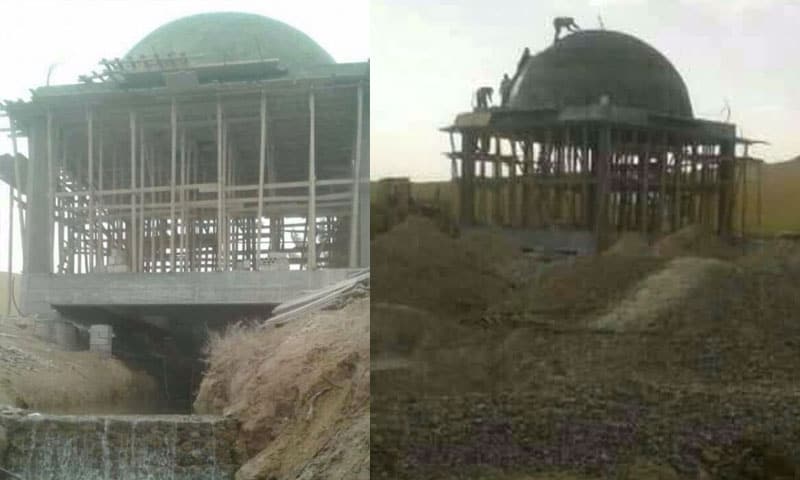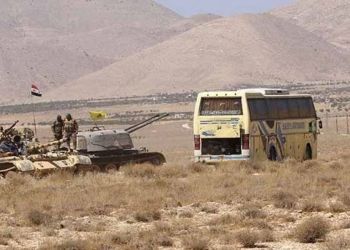This post is also available in:
![]() العربية
العربية
The Iranian Shiite invasion of Deir Ezzor began in the 1980s. During that period, the invasion took the form of indirect invasion or long-range invasion, and its tools were manifested in the form of the planting of seeds of the Shiite sect on the mind of local people. It has been able to recruit a number of people for this task, most notably “Yassin Mayouf” and his relative, “Hussein Raja,” who served as the backbone of the Shiite sect in Deir Ezzor. They worked to implement orders mandate of the Faqih to facilitate the arm of Iran in the region, “Assad’s father system.”
The absence of free media and the control of Assad’s totalitarian regime to the most precise details in the Syrian state are absent from the attention of Iranian practices in Syria in general and Deir Ezzor in particular. Iran’s agents in Deir Ezzor were active at that time period, which lasted until the Syrian revolution. They continued to execute the Iranian plan to spread the Shiite belief in the Druze community of Arab tribal nature.
The village of Hittila, which is located at the entrance to the city of Deir Ezzor in the north-east, is considered the capital of the Shiites in Deir Ezzor, as it is the birthplace of both “Yassin Mayouf” and “Hussein Raja,” who began to spread the call of the Shiites. They played on the ignorance and poverty in a number of villages and towns in the province. They were able to lure the people of some poor villages by enticing them with a monthly salary. The amount reached 7 million dirhams per person in Deir Ezzor in 2007. This mechanism has made a number of Deir-Ezzor residents submit to the material temptations and convert to Shiism. (Albuqmal, New Bakara, Hatala, Maret, Zogir Island, Al Sa’wa, Hamar Al Ali, Kasra) where Husayniyat was clearly established in the villages of the western line “Gezira” and even Adan was raised on Shiism in some mosques of these towns.
After 2011, after the Syrian revolution, and like many projects that were secretly hidden away from the announcement and highlighted, the Iranian project in Deir al-Azur surfaced and unfolds its objectives in the Sunni province with an important strategic location adjacent to Iraq, which is active Iran’s arms Since 2004.
Iran entered the Syrian arena after 2011 explicitly as an international player supporting the Assad regime in Damascus ostensibly, but implicitly was seeking to achieve its sectarian project (Badr Shiite) and secure the international road Tehran – Baghdad – Damascus – Beirut.
The link between Damascus and Baghdad is Dirazur, so the rule of al-Faqih was used to control Deir Ezzor. In 2017, and in the campaign of the Assad regime to control Deir al-Azur, the Iranian presence was strongly present through the multi-national Shiite militias (Lebanese, Iraqi, Syrian, Which was led by Qassem Soleimani, a senior Iranian general.
After Assad’s forces and sectarian militias took control of the southern bank of the Euphrates in Deir al-Zour in late 2017, the Iranian project in Deir al-Zour began to be clearly and quickly revealed.
Where she worked on Iran to build on the nucleus of the consecration created in the province for decades, and activate the characters recruited for this purpose, in addition to the use of new characters from Deirzur able to recruit for the same purpose as Nawaf al-Bashir one of the sheikhs of the Bakara tribe, where he used Bashir as a tool to attract the youth of Deirzal Members of the Bakara clan to embrace the Shiite sect by tempting them with money and power and convincing them of the existence of a hierarchical religious connection between the history of the Bakara tribe and the Al-Bayt family.
Iran also worked to build the houses of worship (the Shiite) of the Hossites and Husayniyat in Deir al-Azur, and to change the names of a number of mosques that were called the names of the companions, such as the conversion of the name of the Omar Mosque in Deir al-Zour to the Radwan mosque, and the use of some mosques as offices to distribute relief aid as a mechanism to attract the people of Deir Al- Shiite by using the need of people who are stuck in the poverty line after the war conditions they have experienced during the years that have been established.
“There is an Iranian militia in the town of Al-Mayadim now controlling a large neighborhood, al-Arbaeen,” says Laith, who can not be named. He does not allow anyone to approach the neighborhood. , So that last week tried a group of Assad forces to enter the neighborhood and the militia punished and humiliated and expelled, no one knows what is going on there.
“Iran is now active in building a large Husseinia building in the Ain Ali archaeological area in Badia al-Qawriya, in the countryside of the city of Mayadim, and apparently it is being prepared to be a Shi’ite shrine in the coming days.”
In recent days, activists have reported that Shiite militias have brought Shiite Iraqi families from Iraq to the city of Bu Kamal, east of Deir Ezzor, and have given them land titles to the displaced people in an effort to expand the demographic change Iran is seeking to impose in Syria and Dirazur.
Iran’s tools in Deir Ezzor ranged from the use of intimidation and coercion against the young people of Deir al-Azur to join the sectarian militias and embrace the Shiite doctrine to protect themselves and their families, and the use of the method of encouragement by providing material temptations and privileges based on the influence of Iranian militias in Syria, in order to achieve its goal of spreading Shiism And to obliterate the historical and religious landmarks of Deir al-Zour and to destroy the social fabric of the province of Asala and ancient history.










